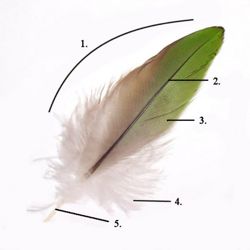|
 Parts of a Contour Feather: 1. Vane 2. Rachis 3. Barb 4. Afterfeather 5. Calamus Feathers are one of the epidermal growths that form the distinctive outer covering, or plumage of birds. They are the outstanding characteristic that distinguishes the Class Aves from all other living groups.
Structure & Function
Principal functions:
- Flight
- Insulation
- Waterproofing
Additional functions
- Courtship displays
- Defence
Cryptic colouring (camouflage)
Colour mimicking
Dominance/subdominance conflicts
- Aggressive territorial behaviour
In most birds, the body is divided into areas that contain feather tracts, pterylae and areas that do not, apteriae. The location and the number of tracts varies between species. By originating from tracts rather than being randomly distributed, feathers can smoothly overlap and conform to the natural contours of the body. By laying feathers over apteriae, air can be trapped beneath, providing insulation.
The portions of the feather can be described as follows:
- Calamus: The short, hollow, tubular, unpigmented end of the mature feather inserted into the feather follicle and thus present below the skin level.
- Rachis: The long solid, tubular extension of the calamus above the skin. The rachis contains pith, which is composed of air-filled keratinised epithelial cells surrounded by a solid keratinised outer cortex.
- Shaft: The combination of the rachis and the calamus.
- Vane or Vexillum: The portion of the feather that extends to either side of the rachis and is composed of the barbs and their associated structures. The vane is either plumulaceous (soft and downy) or pennaceous (compact and closely knit) depending on the individual type of feather.
- Barbs: The series of branches fused to the rachis, constituting the major surface area of the feather. Barbs also have branches called barbules which have hooks that lock the barbs together.
Click here to read more
|